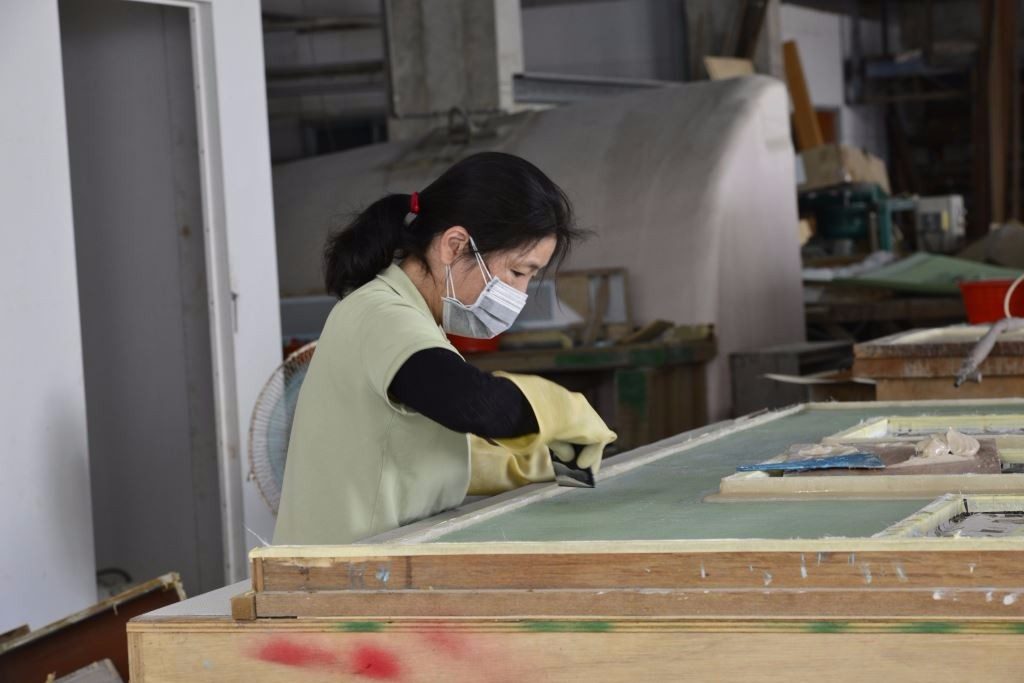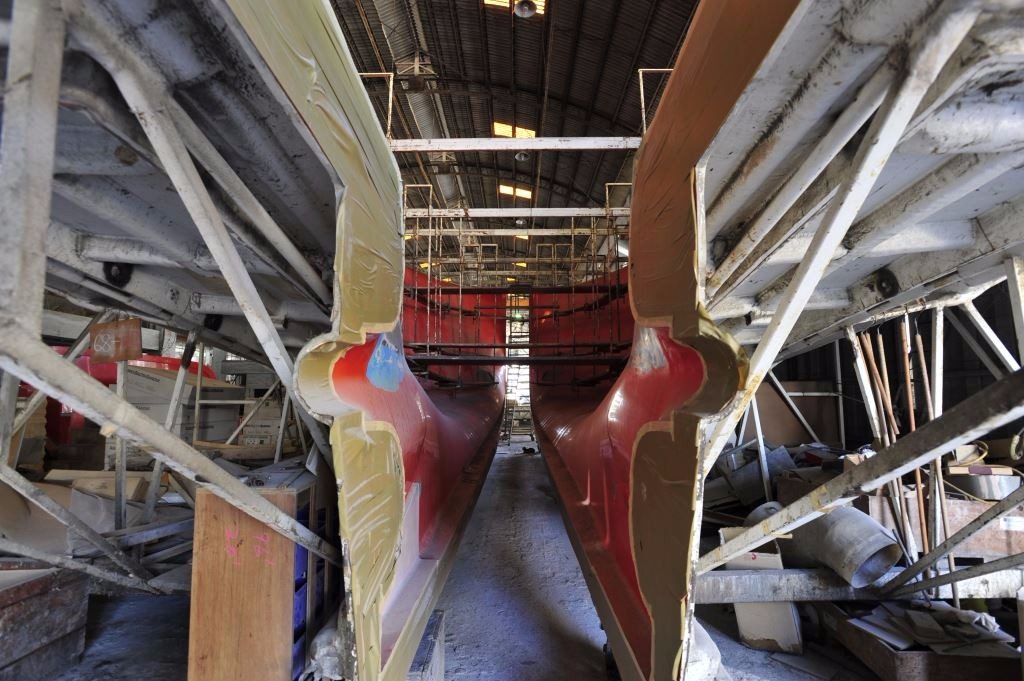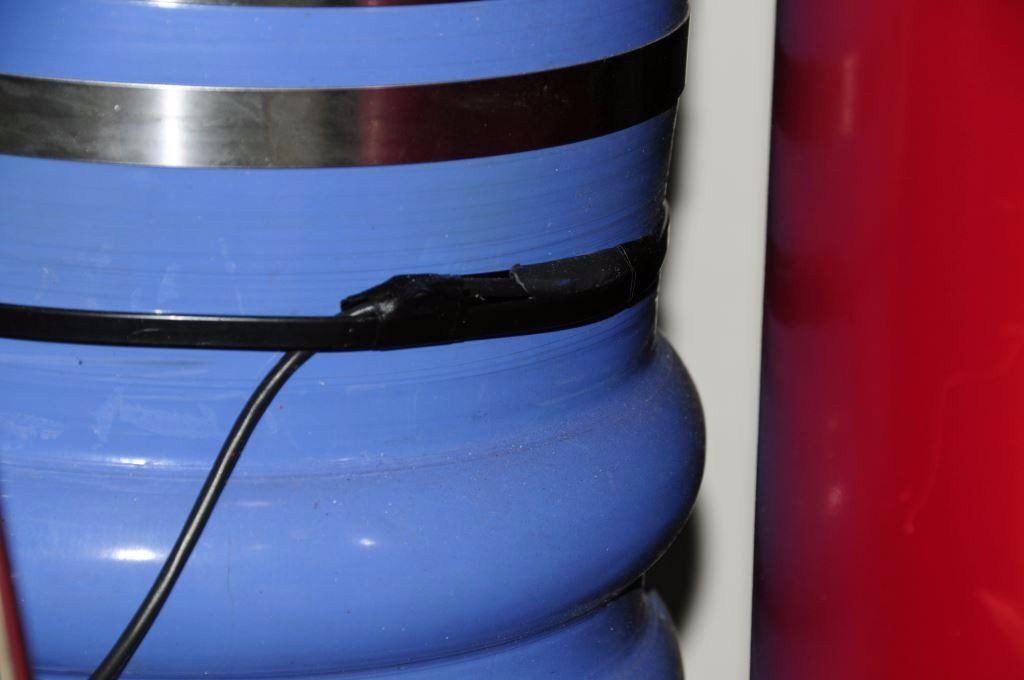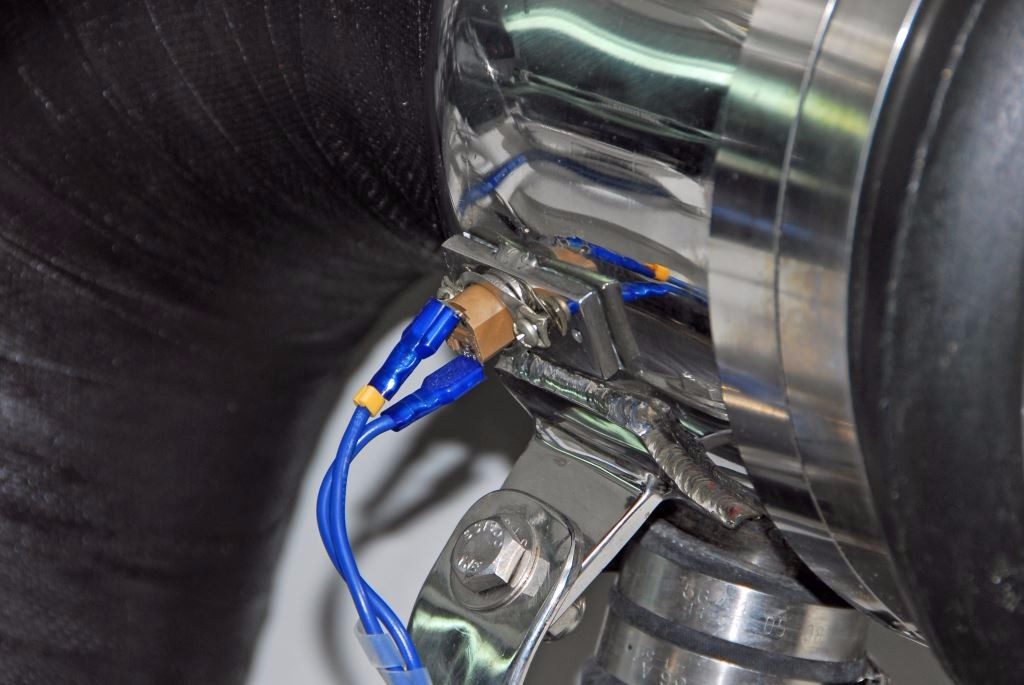Text and photos by Steve D’Antonio
Copyright © 2017
From the Masthead
Taiwan Has Ruined Me
“Made in Taiwan”, it’s a phrase that inaccurately conjures up thoughts in the minds of many that aren’t flattering, inexpensive, cheap, or throw away. In fact, while Taiwan seemingly is one giant workshop, and steel mill, and while much of what comes out of this land is no doubt mass produced, my interaction with Taiwanese boat builders and related craftsmen has been one of boundless admiration. If you can imagine, describe, and draw it, they can build it to whatever specification or standard that suits you, including everything from fine teak and cherry cabinetry, to sophisticated electrical systems, precision drive trains, and of course complete vessels. When I walk through boat yards and shops while there I often marvel at the quality and ingenuity, and what’s more, they almost universally achieve this level of perfection with the simplest of tools, many of which are made by the craftsmen who use them. In all the trips I’ve made to Taiwan, I’ve never seen a store-bought plane, awl, broom or tool box; all are handmade. The roll away tool cabinets owned by mechanics in American boat yards could only be dreamed of by even the most skilled, experienced Taiwanese boat builders. They achieve a great deal with very little.

When I carry out inspections in a Taiwanese boat yard those working there are universally deferential and friendly, most shop floor workers speak little or no English. On virtually every occasion on which I crawl into the recess of an engine room or lazarette, flashlight in hand, within seconds a Taiwanese worker appears with a drop light and a smile. They know I’m there to critique their work, yet they are helpful. Most yard owners and managers are eager for constructive criticism, and virtually all the staff I encounter are sponges for knowledge and learning new and improved techniques. I often think to myself, ‘if they came to an American boat yard to inspect the work we do, would they get that sort of treatment’?
Night street markets are, by the way, not to be missed. The country is essentially devoid of violent crime, and now that I ponder it, I’m not sure I’ve ever even heard a raised voice in public. Taiwanese are simply too busy working or studying, it seems, to descend to this level of unproductiveness.

This attitude does not stop at the shipyard gate; it universally permeates Taiwanese culture, from those working in airports and hotels, to restaurants, airline cabin crews (the national airline, China Airlines, is in my top three favorites) and taxi drivers. In the latter case, every one I’ve encountered, without fail, has been professional and courteous, scrupulously honest, endeavors to get you to your destination as quickly as possible (always wear your seatbelt) and every cab spotless. When they pull up to a curb drivers literally run from their door around to the trunk to unload your luggage, and if you beat them to it they look genuinely disappointed (I’ve learned to walk slowly). They neither expect nor rely on tips; however, if you provide one, and I always do, they are likely to shake your hand, bow or salute. When they send you off, whether it’s at the airport or a train station, it’s as if you are being dropped off by a family member, they always wave, and flash a big smile, and while few speak English, some say a well-practiced “Have a nice trip!”

Service nationwide is orders of magnitude beyond anything you’ve probably ever experienced in Western cultures. Even those doing the most menial jobs, washing windows and mopping floors for instance, take their work seriously and give it their maximum effort, running, as noted previously, is the norm for hotel clerks, and bell hops.
Taiwan’s high speed train, on which I can travel nearly the length of the island, about 200 miles, in 90 minutes, is staffed by some of the most squared away transit workers I’ve ever encountered, anywhere. Their precision, and uniforms, complete with white gloves, leather pouches slung across their chests, and sharp creases, would put many of the world’s armed forces to shame.
Taiwan’s people have, therefore ruined me in many ways; I’m forever measuring service and attentiveness against this impossibly high standard. They are a tough act to follow, and a culture in which I very much enjoy immersing myself.
Photo Essay: Exhaust Temperature Alarms


Most vessel operators, and many professional mechanics alike, believe that the first line of defense against an engine overheat scenario is the engine’s own audible overheat alarm. While the coolant temperature gauge, and audible high temperature alarm are no doubt critical components, by the time the latter sounds, there is a good chance damage has already occurred, either to the engine itself or the water-cooled portions of the exhaust system. Engine blocks possess significant mass, and as such it takes some time for the coolant temperature to reach a point where it will trigger the alarm. By the time that happens, if cooling water has been interrupted by a blocked seacock or strainer, it often means the exhaust system has been operating without cooling water for several minutes. While that may not sound like a lot, consider that the normal temperature of the wet exhaust is somewhere around 150°F, while the dry, uncooled diesel exhaust can range from 400°F to 1,000°F. That sort of heat will very quickly turn a normally water-cooled exhaust hose or fiberglass pipe into toast, which can in turn lead to thousands of dollars’ worth of damage, or worse, lead to a fire.
A wet exhaust temperature alarm will alert a user to this sort of impending scenario long before any damage occurs. In some cases vessel operators have reported to me that in the process of cleaning a strainer they inadvertently left the seacock closed. Anyone who has ever done this knows, in addition to feeling very foolish, it nearly always results in a cooked impeller. In most cases the helmsman is alerted to the oversight when the engine’s high temp alarm sounds, at which point he or she no doubt thinks, “I can’t believe I did that!” For vessels equipped with exhaust temperature alarms, this scenario is all but eliminated; it reacts so quickly, typically within 30 seconds, and it’s threshold is so low, usually around 165°F, that no damage is done; in most cases even the impeller survives unscathed.
When I mention the importance, it’s a requirement for ABYC compliance, and value of a wet exhaust temperature alarm, some skippers, those whose vessels are equipped with raw water flow alarms, believe it’s unnecessary, but they ignore its importance at their own peril, and here’s why. Consider this especially insidious and potentially disastrous scenario, one I’ve encountered on several occasions; the raw water hose between the engine’s heat exchanger outlet and exhaust injected elbow parts or slips off its pipe to hose adapter. Because the engine is still receiving cooling water, it doesn’t overheat, the flow indicator registers no problem, and no alarms sound, all the while seawater is being pumped into the engine room, and possibly spraying onto the engine. The first sign of trouble is often the sounding of the high water alarm, if the vessel is equipped with one and it’s working. The wet exhaust temperature alarm offers the greatest protection against a range of failure scenarios, including this one.
There is one additional nuance worth mentioning when selecting or evaluating a wet exhaust temperature alarm, which involves the placement of the sensor. In order to ensure the most rapid reaction time, the sensor, which should be a quick-acting thermistor, must be strapped to the exhaust hose immediately downstream of the injected elbow. However, some installations, particularly those installed by production boat builders, rely on a sensor that is screwed to the metallic injected elbow itself. While this is better than no sensor at all, most injected elbows are made up double wall pipe, with the void between them normally filled with seawater. If the water supply is interrupted, however, that void is filled with air, which is a poor conductor of heat, which in turn delays the alarm from being triggered, as it takes longer for the metal’s temperature to reach the trigger point.
Under no circumstances should the sensor pierce the hose, or be exposed to directly to seawater. Such an arrangement, if it fails, could lead to the introduction of atomized seawater and exhaust into the engine room, a catastrophic occurrence if ever there was one. This is entirely unnecessary; a sensor strapped to a hose will react rapidly and last far longer.
In the accompanying images are examples of both the hose (top) and metallic injected elbow-located sensors. The former is not only more effective, it uses a thermistor, it’s easier to install, it’s simply strapped in place. Because most do not include a self-test feature, wet exhaust alarms should be tested at least annually using a heat gun and infrared pyrometer, with the sensor being heated until the alarm sounds, and the pyrometer registering the temperature at which it was triggered. Power for exhaust temperature alarms should be drawn directly from the engine’s ignition circuit, to ensure they are passively active whenever the engine is running.
Ask Steve
Steve,
In your Ask Steve column you had a reader requesting a way to get the last little bit of water out of the bilge, wouldn’t a system such as the Arid Bilge be a better choice for really dry bilges?
Thank you,
Dan Winchester
Dan:
The Arid Bilge system is effective at removing small amounts of water from shallow bilges without bilge wells, where a conventional bilge pump will not work. I have no reason to believe using it in an application like the one included in the ‘Ask Steve’ column wouldn’t work, albeit at comparative high cost, with greater complexity, and with a larger foot print, when compared to a conventional low profile bilge pump like the one I recommended. The Arid Bilge claim to fame is its ability to remove virtually every drop of water, whereas even a small self-priming bilge pump is likely to leave some water behind, albeit a small quality.
A few years ago a client inquired about such a bilge drying system. I asked him why he believed he needed it. His response, “Because there’s always water in my bilge” gave me pause. I knew the vessel well and I could think of no source of water that would lead to a perpetually wet bilge. I suggested he have a technician come aboard and carry out a thorough check of the raw water plumbing before investing in the bilge drying system.
I received a call a week later, in which he revealed the source. During the refit a technician had used a high zinc-content red brass close pipe nipple for the air conditioning raw water discharge fitting. Brass with a zinc content greater than 15% should never be used for raw water applications, this one lasted roughly eight months before it corroded and sprang a leak, several actually, whenever the air conditioning ran it behaved like a miniature sprinkler. When it ultimately failed, the vessel would have flooded rapidly.
The moral of the story applies to any bilge water, regardless of the pumping system; identify the cause before dealing with the symptom.
Hi Steve,
We have corresponded before and this is a question about dripless stuffing boxes. After reading your recent article on dripless stuffing boxes I thought I would write you about my experience with them to see if any of your readers or you have had the experience I had.
I have a 1984 Jersey 40 with cat 3208 300HP engines and 1 3/4 inch shafts. When I first got the boat I had dripless stuffing boxes installed and I had a lot of problems with vibration. After having the props worked on and the shafts checked I was told it was the stuffing boxes, the shafts have a fairly long run that is unsupported. I removed the dripless stuffing boxes and put the old ones back (packing type) the problem seemed to stop but I still had some vibration. Finally I took the props to a prop shop that had the latest technology in prop tuning and balancing and the problem went away.
Do you think that the problem was a prop problem and I could put back the dripless stuffing boxes or do some stuffing boxes act as an intermediate support?
I do not see any indication of wear or rubbing of the shaft in the stuffing box and it runs nice and cool even after many running hours.
Thanks for a great column.
Jerry Marmer
Jerry:
When it comes to shaft support, formulas to calculate the required bearing spacing are available in the ABYC Standards. Barring the use of those, the rule of thumb is as follows, supports should be no further apart than 40 shaft diameters (and no less than 20 shaft diameters), which in this case is 70 inches. If the distance between the shaft coupling and the bearing is greater than this distance, then shaft whip or vibration is not uncommon, and it sounds as if that’s what’s occurring. Because of its rigidity, it’s possible that your conventional stuffing box was acting as a support, stifling vibration or whip. If the stuffing box is rigidly mounted, without a hose as some are, then this is almost guaranteed, and such installations are considered supplemental support.
The fact that the vibration was eliminated or diminished after the props were reconditioned is encouraging. However, I would not consider returning to the dripless stuffing boxes if the distance between shaft supports or bearings exceeds the above-mentioned formula, as it’s likely the conventional stuffing box is providing a measure of support, and keeping shaft whip under control.
Hi Steve,
I attended your spring Trawler Training workshop, which was great by the way, and thought I would touch base with you on this.
This past weekend I had an unfortunate encounter with a submerged uncharted rock that damaged one of my props on my 1999 Azimut 46. After the boat was hauled and the yard manager took a look he asked if I knew anything about the discoloration of the props. He said it looked like a “halo” effect possibly from heat treating or corrosion. I’ve only owned the boat for a little over a year and nothing was ever mentioned about them. I purchased the boat from the original owner. Can you tell anything from these pictures?
Appreciate any insight you may have.
Thanks,
Dan
Dan:
Ouch…operating vessels without keels places special burdens on navigators. I hope the repairs weren’t too costly. On the bright side, whatever the cost, if you had pods you probably could have tripled it.
I love a good metallurgical mystery. Unfortunately I don’t believe this is one of them (and once cast, bronze propellers are not heat treated per se). If this were a corrosion issue the metal would be bright and clean, and pitted, and that doesn’t appear to be the case. If I had to hazard a guess, based on the photos alone, I’d say it’s a mild case over-zincing, which is a bit like the opposite of corrosion. In that case, an alkaline solution is formed around protected underwater metals, which can cause this sort of discoloration. It’s not harmful per se (other than to aluminum and timber vessels). If you were concerned, it could be tested and verified by a (preferably ABYC certified) corrosion technician using a reference electrode and a multi-meter.
Steve,
What is the best way to deal with a shore power receptacle that does not match our cord?
We have finally arrived at a marina with power. But the receptacle is a different configuration. Should we have a marine electrician change the end on our power cord??
I read in a boaters blog that “serious boaters” (not sure who that is or is not) often have a junction box at the end of their shore power cord, and then wire the local plug fitting to the junction box.
Is this feasible? Advisable? Dealing with high voltage is daunting….
Thanks for any guidance here…
Ann Evans
Ann
Chilean shore power is 240 volts 50 hz. Are you going to supply this to the whole boat? If so there are a slew of caveats that go along with doing this. The primary issue is the 50 Hz frequency, not everything you have aboard can run on it properly including refrigeration, some compressors and motors. Some HVAC compressors and systems are designed to operate on either frequency, others are not. Of those that do, some specify that when running a system designed for 60 Hz on 50Hz the voltage needs to be reduced as well. While many users report being able to run household appliances designed for 60 Hz on 50 Hz with no issues, other than clocks running slow, you do so at your own risk, many manufacturers prohibit it and failures do occur. Again, there are many issues to consider.
To answer your question, unless you are comfortable wiring the adapter then yes have an electrician either changer your cord end or preferably make an adapter. For the latter he or she will need a local male plug and a North American 50 amp 240 volt female plug, this is really the preferred option, because you can then wire any other male plug to this “pigtail” .
I wouldn’t go the junction box route. As noted above I’d simply have a female plug that plugs into the male end of your shore power cord. Into that plug you can then wire any local male plug, which will then be your adapter.


